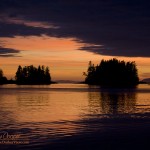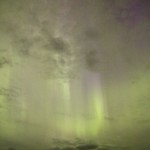This trip to Alaska offered an opportunity that I had not experienced on previous trips due to the confluence of two conditions… I would be visiting later in the year than usual, it would actually get properly dark. When visiting Southeast Alaska in June and July the amount of darkness is dramatically limited by long summer days. The second condition is even less easily arranged… Our Sun is near the peak of its eleven year solar cycle. This results in more solar activity including large sunspots and energetic solar flares.
Put the two of these factors together and there is a good possibility of seeing the Aurora Borealis.
It is only a possibility, not a certainty by any measure… This was not a trip to the far north, where the auroral circle usual sits. If one were to travel north of Fairbanks into the true arctic one is almost guaranteed to see the aurora during solar max. I would be traveling between Juneau and Anacortes, from 58 to 48 degrees north latitude. At these latitudes it would take a strong geomagnetic storm to bring the aurora south into view. The chances of such a strong storm were relatively good, we are currently experiencing an active Sun near solar maximum, averaging a decent storm every month or two. In any case the odds were a bit better than seeing the aurora at home in Hawai’i.
At least there would be no light pollution to deal with, significant outposts of civilization are sparse along the route we would be traveling. One complication would be weather… Of the twenty days I would spend in northerly latitudes, about half were clouded over, thus the odds of seeing a good auroral display were modest, maybe even unlikely.
We got lucky.

I was not quite sure what we were seeing, a steady, straight line of light glowing high in the west. A high altitude cloud or contrail catching a little twilight glow? It was not yet full dark and high altitude illumination from the Sun was a possibility. Switching off all the external lights on the boat did not provide any better view or answers.
As we watched the darkening sky ever more was visible, slowly patches and curtains of light appeared. As it moved across the sky there was no question as to what we were witnessing.

I did record the display, I set up the tripod atop the boat and took quite a few photos. The camera showed most of the glow as bright green, with a background of violet. With the boat slowly swinging at anchor I was unable to use the longer exposures I would have preferred. To or three seconds was the limit, anything longer was badly blurred by the motion. I had to turn up the camera gain to compensate, resulting in somewhat grainy photos.
Later, when we again had internet connectivity I looked up the solar conditions to discover what had happened. A large coronal mass ejection had been ejected from the Sun several days earlier on August 30th resulting in a strong geomagnetic storm. Good auroral displays had been reported across the high northern and southern hemispheres.
As we had been out of contact, there had been no alert for us, it had found us by surprise, a very pleasant surprise.
Check out the video below for a nice view of the solar flare that produced this particular geomagnetic storm. A dramatic show on the Sun that produced a dramatic effect when it reached our planet…

